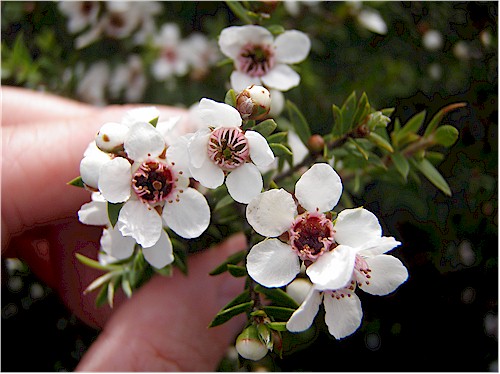Mānuka Honey
What is Mānuka Honey?
Mānuka honey is a monofloral honey produced from the nector of the Mānukatree (Leptospermum Scoparium). This tree is found exclusively in New-Zealand en South-East Australia.
This type of honey has a unique and strong flavor and had a dark brown color. Mānuka honey is known for its special antibacterial qualities, that are expressed in UMF- or MGO-values (more further on).
Why you have to pay attention whilst buying Mānuka honey?
- Avoid packings without information about the UMF (Unique Manuka Factor) or MGO (Methylglyoxalconcentration).When you see a label with only "manuka honey 10+" printed on it, this could mean that it is a TAA or total activity of 10+, including hydrogen peroxide activity (see below). In this case, there are no lies on the packaging, but the seller chooses to leave critical information behind, and in that way he deceives the consumer.
- Look out for a MGO-value of at least 85+.
-
When you find manuka honey for sale at a bargain price? Then you might also have to deal with a product of lower quality. Even residents of New Zealand pay more than $ 30, - (€ 20) for a jar of low active Manuka Honey .
In Europe, of course, you pay more through transport and import costs.
Antibacterial components (Mānuka) honey
Each pure, unprocessed honey has three characteristics that makes honey to be considered as anti-bacterial. That is why people use honey, since ancient times, as a kind of miracle cure and for wound healing
1. Hydrogen peroxide
Before hydrogen peroxide has been identified correctly, scientists referred to it by the name of inhibin. Hydrogen peroxide is generated by the enzyme glucose oxidase, which is added to the nectar by bees during the production process. This enzyme, and thus hydrogen peroxide is sensitive to light and heat, so it is better to never heat honey above 50 ° C, and always keep it in a dark place.
2. Low moisture content
The proportion of water in honey ranges between 15% and 21%. Due to the interaction of the water molecules with monosaccharide molecules (the most simple form of sugar), only a small and insufficient amount of water is available for the growth of bacteria.
3. The acidity
Thanks to it's relatively high acidity (pH 3.2 <x <4.5), honey creates an unsuitable environment for bacteria to grow and survive.
Furthermore, there is a fourth anti-bacterial component that is'nt available in every type of honey:
4. Non-peroxide antibacterial activity
This form of anti-bacterial activity is only to be found in manuka honey.
Unique Manuka Factor (UMF) and Methylglyoxal (MGO)
Not all manuka honey has a high non-peroxide antibacterial activity! To measure the degree of this "unique" non-peroxide antibacterial activity and communicate it to the consumer, professor Peter Molan of Waikato University Honey Research Unit, invented the "UMF" unit (Unique Manuka Factor). Scientists test the antiseptic effect of manuka honey by comparing them to a standard antiseptic agent (phenol or carbolic acid) so as to determine the UMF. UMF 15+ has the same antibacterial or antiseptic effect as a 15% phenol / water solution. UMF 5+ corresponds to 5% phenol / water, UMF 10+ with 10% phenol / water, etc.
UMF is an international trademark, and only owners of a registered license may use the UMF scale. These traders meet predetermined criteria to determine whether the product they deliver is natural, unadulterated manuka honey that contains the unique non-peroxide antibacterial activity. It is utterly important to make sure that this information is conveyed truthfully on the label.
This factor is usually between 0 and 20, wherein 20 is the highest factor (but is very rare).
The UMF in manuka honey depends on two factors:
1. Purity
The term "mono-floral" honey is partly misleading. A mono-floral honey always contains a proportion of other nectar species than just the kind where the honey is named after. Mono Floral honey is actually 'predominantly one kind. As a result, the degree of purity can vary between 50% and 100%. The greater the proportion of nectar in manuka honey, the higher the UMF rate.
2. Geographical origin
Manuka honey comes mainly from the north of New Zealand is known for its high UMF. Other regions of New Zealand produce Manuka variable Unique Manuka Factor or even manuka honey where no non-peroxide antibacterial activity is detected.
Instead of using the UMF scale, one can according to Professor Thomas Henle of the University Dresden also measure the non-peroxide activity by the amount of Methylglyoxal which is present in honey. This can range from 30mg / kg to 900mg / kg. Again, the higher the value, the better. A MGO-value of about 85 mg / kg is comparable to UMF 5, in order to obtain UMF 10 you need to have a MGO-value of 263 mg / kg. UMF 15 methylglyoxal value has been going up to 514 mg / kg.
Supply Vs. Demand
Because the hydrogen peroxide antibacterial activity, that occurs in all kinds of pure honey, is not effective against all species of bacteria; manuka honey is highly prized. Each year, however, it there is only 1500-2000 tonnes of manuka honey harvested, and that doesn't garrantee that all honey has high UMF. The demand for Manuka honey is increasing worldwide, but the offer is unpredictable and uncertain. All these factors make the price of manuka honey is increasing steadily.
Consumers are often fooled
Unfortunately, we can conclude that enormous companies abuse the existence of the UMF scale. This scale serves only to express the non-peroxide activity that is present in pure, high quality manuka honey.
By summing up the non-peroxide activity to the hydrogen peroxide activity that occurs in all types of honey (this sum makes the Total Activity or TA) and this brought together under one value on the product label, may misleid consumers into believing that they bought highly active manuka honey. In reality, however, these consumers purchased inactive manuka honey, where only the hydrogen peroxide antibacterial activity bears to the "high" factor.
Interesting Literature:
http://www.purenewzealandhoney.com/umf-manuka-honey/
http://www.umf.org.nz/umf-trademark/methylglyoxal-npa-honey-conversion-calculator



